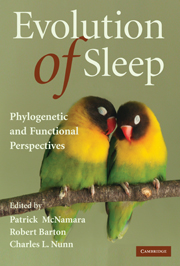Book contents
- Frontmatter
- Contents
- Contributors
- Acknowledgments
- Introduction
- 1 Ecological constraints on mammalian sleep architecture
- 2 Sleep in insects
- 3 Schooling by continuously active fishes: Clues to sleep's ultimate function
- 4 What exactly is it that sleeps? The evolution, regulation, and organization of an emergent network property
- 5 Evolutionary medicine of sleep disorders: Toward a science of sleep duration
- 6 Primate sleep in phylogenetic perspective
- 7 A bird's-eye view of the function of sleep
- 8 The evolution of wakefulness: From reptiles to mammals
- 9 The evolution of REM sleep
- 10 Toward an understanding of the function of sleep: New insights from mouse genetics
- 11 Fishing for sleep
- Index
- Plate section
- References
9 - The evolution of REM sleep
Published online by Cambridge University Press: 10 March 2010
- Frontmatter
- Contents
- Contributors
- Acknowledgments
- Introduction
- 1 Ecological constraints on mammalian sleep architecture
- 2 Sleep in insects
- 3 Schooling by continuously active fishes: Clues to sleep's ultimate function
- 4 What exactly is it that sleeps? The evolution, regulation, and organization of an emergent network property
- 5 Evolutionary medicine of sleep disorders: Toward a science of sleep duration
- 6 Primate sleep in phylogenetic perspective
- 7 A bird's-eye view of the function of sleep
- 8 The evolution of wakefulness: From reptiles to mammals
- 9 The evolution of REM sleep
- 10 Toward an understanding of the function of sleep: New insights from mouse genetics
- 11 Fishing for sleep
- Index
- Plate section
- References
Summary
Introduction
Since the dawn of civilization, sleep has fascinated humankind. Myriad treatises and reviews, scientific and nonscientific, have been written in an attempt to explain the phenomenon of sleep, yet none has been comprehensive enough to gain general acceptance. It is now well established that sleep is neither a unitary nor a passive process. Intricate neuronal systems via complex mechanisms are responsible for controlling sleep. This chapter focuses on the evolution of rapid-eye-movement (REM) sleep; for detailed information about other behavioral states, the reader is referred to several comprehensive reviews (Datta & Maclean, 2007; Jones, 2003; Mignot, 2004; Siegel, 2004; Steriade & McCarley, 2005). We begin with a brief description of the discovery of REM sleep and then describe the phylogeny and evolution of REM.
Discovery of REM sleep
The discovery of REM sleep, a major breakthrough, revolutionized the field of sleep research. The process that led to this discovery began in Kleitman's laboratory at the University of Chicago Medical School in 1953. Kleitman and his graduate student Eugene Aserinsky noticed rhythms in eye movements during sleep in humans and linked this to dreaming (Aserinsky & Kleitman, 1953, 1955). Subsequently, Dement and Kleitman (1957) characterized the electroencephalographic (EEG) activity during dreaming in humans, and later Dement (1958) recorded rapid eye movements during sleep in animals. These discoveries established the presence of the non-REM–REM sleep cycle.
- Type
- Chapter
- Information
- Evolution of SleepPhylogenetic and Functional Perspectives, pp. 197 - 217Publisher: Cambridge University PressPrint publication year: 2009
References
- 1
- Cited by



